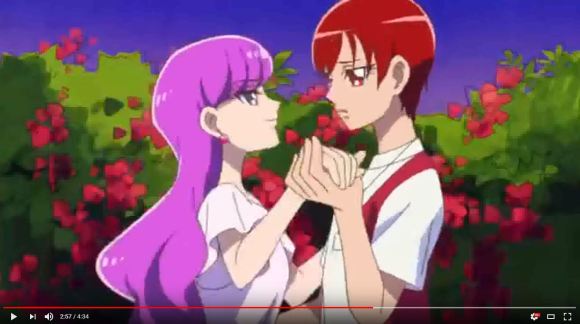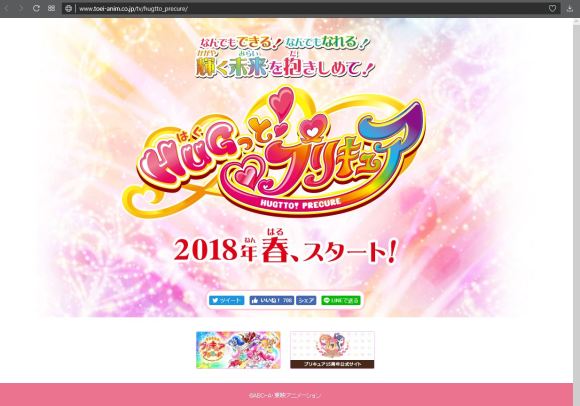
This long-running children’s series may not be doing it on purpose, but is making significant strides in LGBT acceptance in Japan.
Toei-Animation recently announced that the next iteration of Pretty Cure will begin in Spring of 2018 titled Hugtto Pretty Cure. This is normal for the Pretty Cure franchise which reboots with new characters, plot lines, and merchandising opportunities every year.
● Hugtto Pretty Cure
For those unfamiliar with the show, Pretty Cure is a long-running anime series that began in 2004 in which teenage girls gain magical powers to battle the forces of evil. The series is hugely popular with young girls in Japan and has a massive line of toys, along with live musical shows that draw large crowds.
With the announcement Hugtto Pretty Cure one 2-chan poster remarked: “This is totally going to be a lesbian anime…”
At first, that might seem like a crass assessment of a show aimed at little girls, but if you’ve watched Pretty Cure you’d quickly find that it’s not unwarranted.
● Chocolate Macarons anyone?
My first experience with Pretty Cure came with the current season Pretty Cure A La Mode as my daughter had just gotten old enough to get into it. In A La Mode there is a team of five girls who use the combined powers of animals and baked goods to battle with.
It had surprisingly good action scenes considering they were essentially just throwing giant cakes at their foes. However, while watching, it didn’t take long to notice that something was going on between the two older teammates of the group. Of course, my daughter didn’t pay it any mind, but any adult could easily tell that Cure Chocolat (the brown one) and Cure Macaron (the purple one) were totally into each other.
This subtext is both so obvious and yet so coy, it’s actually rather impressively handled. To give you a quick sense, here is a fan-made video showing some of the pair’s more intimate moments over the season.
These two characters are said to be based on roles in the all-female Takarazuka Revue, a legendary theatre company in Hyogo Prefecture. While the character designs are certainly a homage, there is still more to unwrap with this show.
● Yuri Fanbase
The previous music video clearly wasn’t made by a six-year-old, so you can probably realize that there is a wider fanbase to Pretty Cure than meets the eye. Digging a little into the series’ past seasons, there has been a growing number of yuri fans getting behind these magical girls. Yuri is a genre of manga and anime that deals with romantic relationships between female characters.
https://twitter.com/Mayapinpinpin/status/926975826574196737Given the themes of camaraderie between young women in Pretty Cure, it is no surprise that yuri fan fiction began to arise. It is, however, a surprise that Toei-Animation has clearly been playing into this and adding yuri elements to the series without getting too explicit.
Nothing against yuri, but this is a little sad because at first I was hoping the creator was simply trying to raise awareness of LGBT equality and acceptance among the youth of Japan. However, considering the creator and writer of Pretty Cure is Izumi Todo, a pseudonym for the entire corporate entity of Toei-Animation, it is rather likely that they just found an exploitable market to tap into.
● Akira Kenjo doesn’t owe us an explanation
Back when my four-year-old daughter was first teaching me about the Pretty Cure lore I noticed that Chocolat was the only one dressed in suits and had the real name of Akira which is a rather unisex name. So I asked, “Is Cure Chocolat a boy?”
“No,” she answered, “because Pretty Cure is all girls.”
“But Chocolat has pants, and is named Akira… and kind of looks like a boy.”
“Yes, Chocolat is a boy.”
“Hmm…”
Watching the anime yielded little clarity as well. I watched as the feminine-yet-deep-voiced (by former Takarazuka member Nanako Mori) Chocolat and Macaron gave each other doe eyes. I grew increasingly frustrated that the show never definitively explained what gender or sexual orientation Akira is and if there really was anything going on between her and Cure Macaron.
⑦剣城あきら(キュア・ショコラ)
— 鷹取 諒☆セラムンコスプレ部 (@takatorixx2) November 9, 2017
元々撮影のお話があったんですよ(笑)
あきら様は私服やパティシエ服、ショコラちゃんも色々したいキャラです(๑´꒳`๑) pic.twitter.com/gDjperFPRo
However, while my crusty old brain was busy trying to assign gender roles, my daughter was just enjoying Chocolat, Macaron, and the rest for what they were – and that’s pretty cool.
Akira never explains herself or her actions in the show, and she shouldn’t have to at all. Sadly, it took me a bit to figure out, but my kid already gets it and hopefully she’ll carry that attitude with her as she grows up.
● Back to the future of Pretty Cure
It’s no secret that Japan isn’t really known for its touchy-feely personal interactions, and hugging isn’t very common. So while westerners might find “hug” to be an innocent concept, given what we’ve just learnt about the series, there does appear to be some foreshadowing of more heavy-handed yuri content to come.
Of course, in order to keep the revenue flowing from the much more lucrative little girl market, they can’t go too far without drawing the wrath of conservative parents. It’s obvious that the real reason Akira doesn’t come out is because the backlash would be bad for Toei-Animation’s bottom line. But for kids, it simply comes across that her and Macaron’s orientation is not a big deal – which incidentally is exactly how it should be.
And so, as it has before and as it will in the future, this yin and yang of yuri fans and kid fans has – in an amazingly unintentional way – resulted in Pretty Cure being one of the more progressive children’s series around, featuring positive and grounded female role models living alternative lifestyles free of judgment.
Source: Toei-Animation, Kinisoku
Top image, video: YouTube/Luna Midnight
Insert image: Toei-Animation


 After 15 years, the first male Pretty Cure has arrived… perhaps
After 15 years, the first male Pretty Cure has arrived… perhaps Pretty Cure fans stoked to see four Pretty Cure characters represented on Tokyo 2020 merchandise
Pretty Cure fans stoked to see four Pretty Cure characters represented on Tokyo 2020 merchandise Latest Pretty Cure movie gets Guinness World Record on opening day
Latest Pretty Cure movie gets Guinness World Record on opening day Pretty Cure fan reveals cost of purchasing every DVD and CD of the anime series, and it’s a lot
Pretty Cure fan reveals cost of purchasing every DVD and CD of the anime series, and it’s a lot Doctors Without Borders Japan gets a birthday greeting from the anime world
Doctors Without Borders Japan gets a birthday greeting from the anime world Foreigner’s request for help in Tokyo makes us sad for the state of society
Foreigner’s request for help in Tokyo makes us sad for the state of society Japanese city loses residents’ personal data, which was on paper being transported on a windy day
Japanese city loses residents’ personal data, which was on paper being transported on a windy day Akihabara pop-up shop sells goods made by Japanese prison inmates
Akihabara pop-up shop sells goods made by Japanese prison inmates Harajuku Station’s beautiful old wooden building is set to return, with a new complex around it
Harajuku Station’s beautiful old wooden building is set to return, with a new complex around it Historical figures get manga makeovers from artists of Spy x Family, My Hero Academia and more
Historical figures get manga makeovers from artists of Spy x Family, My Hero Academia and more Sandwiches fit for a sumo served up in Osaka【Taste Test】
Sandwiches fit for a sumo served up in Osaka【Taste Test】 Ghibli Park now selling “Grilled Frogs” from food cart in Valley of Witches
Ghibli Park now selling “Grilled Frogs” from food cart in Valley of Witches Red light district sushi restaurant in Tokyo shows us just how wrong we were about it
Red light district sushi restaurant in Tokyo shows us just how wrong we were about it Beautiful Ghibli sealing wax kits let you create accessories and elegant letter decorations【Pics】
Beautiful Ghibli sealing wax kits let you create accessories and elegant letter decorations【Pics】 What did Mark Zuckerberg eat at McDonald’s in Japan, and is it as great as he says it is?
What did Mark Zuckerberg eat at McDonald’s in Japan, and is it as great as he says it is? McDonald’s new Happy Meals offer up cute and practical Sanrio lifestyle goods
McDonald’s new Happy Meals offer up cute and practical Sanrio lifestyle goods Japanese ramen restaurants under pressure from new yen banknotes
Japanese ramen restaurants under pressure from new yen banknotes French Fries Bread in Tokyo’s Shibuya becomes a hit on social media
French Fries Bread in Tokyo’s Shibuya becomes a hit on social media Studio Ghibli releases new action figures featuring Nausicaä of the Valley of the Wind characters
Studio Ghibli releases new action figures featuring Nausicaä of the Valley of the Wind characters New private rooms on Tokaido Shinkansen change the way we travel from Tokyo to Kyoto
New private rooms on Tokaido Shinkansen change the way we travel from Tokyo to Kyoto Tokyo Tsukiji fish market site to be redeveloped with 50,000-seat stadium, hotel, shopping center
Tokyo Tsukiji fish market site to be redeveloped with 50,000-seat stadium, hotel, shopping center All-you-can-drink Starbucks and amazing views part of Tokyo’s new 170 meter-high sky lounge
All-you-can-drink Starbucks and amazing views part of Tokyo’s new 170 meter-high sky lounge Studio Ghibli releases Kiki’s Delivery Service chocolate cake pouches in Japan
Studio Ghibli releases Kiki’s Delivery Service chocolate cake pouches in Japan New definition of “Japanese whiskey” goes into effect to prevent fakes from fooling overseas buyers
New definition of “Japanese whiskey” goes into effect to prevent fakes from fooling overseas buyers Our Japanese reporter visits Costco in the U.S., finds super American and very Japanese things
Our Japanese reporter visits Costco in the U.S., finds super American and very Japanese things Studio Ghibli unveils Mother’s Day gift set that captures the love in My Neighbour Totoro
Studio Ghibli unveils Mother’s Day gift set that captures the love in My Neighbour Totoro More foreign tourists than ever before in history visited Japan last month
More foreign tourists than ever before in history visited Japan last month New Pokémon cakes let you eat your way through Pikachu and all the Eevee evolutions
New Pokémon cakes let you eat your way through Pikachu and all the Eevee evolutions Sales of Japan’s most convenient train ticket/shopping payment cards suspended indefinitely
Sales of Japan’s most convenient train ticket/shopping payment cards suspended indefinitely Sold-out Studio Ghibli desktop humidifiers are back so Totoro can help you through the dry season
Sold-out Studio Ghibli desktop humidifiers are back so Totoro can help you through the dry season Japanese government to make first change to romanization spelling rules since the 1950s
Japanese government to make first change to romanization spelling rules since the 1950s Ghibli founders Toshio Suzuki and Hayao Miyazaki contribute to Japanese whisky Totoro label design
Ghibli founders Toshio Suzuki and Hayao Miyazaki contribute to Japanese whisky Totoro label design Doraemon found buried at sea as scene from 1993 anime becomes real life【Photos】
Doraemon found buried at sea as scene from 1993 anime becomes real life【Photos】 Tokyo’s most famous Starbucks is closed
Tokyo’s most famous Starbucks is closed One Piece characters’ nationalities revealed, but fans have mixed opinions
One Piece characters’ nationalities revealed, but fans have mixed opinions We asked a Uniqlo employee what four things we should buy and their suggestions didn’t disappoint
We asked a Uniqlo employee what four things we should buy and their suggestions didn’t disappoint Princesses, fruits, and blacksmiths: Study reveals the 30 most unusual family names in Japan
Princesses, fruits, and blacksmiths: Study reveals the 30 most unusual family names in Japan Video highlights some of the disturbing Pretty Cure live show bloopers
Video highlights some of the disturbing Pretty Cure live show bloopers We use makeup from Japanese kids’ anime Tropical-Rouge! PreCure on our adult faces【Photos】
We use makeup from Japanese kids’ anime Tropical-Rouge! PreCure on our adult faces【Photos】 Children’s anime PreCure features magical girl actually giving birth to a child in series finale
Children’s anime PreCure features magical girl actually giving birth to a child in series finale For the not-so-low cost of US$1,300 you can own almost every Pretty Cure collector’s badge set
For the not-so-low cost of US$1,300 you can own almost every Pretty Cure collector’s badge set Hackers to Gundam: 5 rumors about failed North Korean missile launch surface on Japanese Internet
Hackers to Gundam: 5 rumors about failed North Korean missile launch surface on Japanese Internet City in Japan receives donation for kids with letter signed by two ultra-popular anime characters
City in Japan receives donation for kids with letter signed by two ultra-popular anime characters Japanese wife becomes Internet’s favorite when she replaces dollhouse bunny with Zangiefs
Japanese wife becomes Internet’s favorite when she replaces dollhouse bunny with Zangiefs Demon Slayer and Pretty Cure anime-themed Happy Meals arrive at McDonald’s Japan
Demon Slayer and Pretty Cure anime-themed Happy Meals arrive at McDonald’s Japan If The Avengers could have one Japanese superhero, who would it be?
If The Avengers could have one Japanese superhero, who would it be? Will anime contest for little kids end with magical girls visiting the home of a middle-aged guy?
Will anime contest for little kids end with magical girls visiting the home of a middle-aged guy? Japanese kids can get boo-boos treated by augmented reality anime characters in Bandai-d form
Japanese kids can get boo-boos treated by augmented reality anime characters in Bandai-d form Naruto’s son gets a voice as lead roles cast for Boruto –Naruto the Movie-
Naruto’s son gets a voice as lead roles cast for Boruto –Naruto the Movie- Try a super-easy summer cold remedy with this natural Honey Daikon Cough Syrup recipe
Try a super-easy summer cold remedy with this natural Honey Daikon Cough Syrup recipe Wrinkly Pikachu gets first-ever official plushie, sadness-smoothing hugs to come soon
Wrinkly Pikachu gets first-ever official plushie, sadness-smoothing hugs to come soon Snoopy’s Japanese-style tea house opens new location, brings Snoopy Chocolat along as a bonus
Snoopy’s Japanese-style tea house opens new location, brings Snoopy Chocolat along as a bonus
Leave a Reply